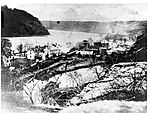John Brown's Fort

John Brown's Fort was originally built in 1848 for use as a guard and fire engine house by the federal Harpers Ferry Armory,in Harpers Ferry, Virginia (since 1863, West Virginia). An 1848 military report described the building as "An engine and guard-house 35 1/2 x 24 feet, one story brick, covered with slate, and having copper gutters and down spouts…"The building achieved fame when it became the anti-slavery advocate John Brown's refuge during his 1859 raid on Harper's Ferry, in which he hoped launch the overthrow of slavery. It is the only surviving building of the Armory; the others were destroyed during the Civil War. The building quickly became a tourist attraction; the words John Brown's Fort—a new name—were painted over the three doors, to attract tourists. It has been moved four times: in 1891 to the World's Columbian Exposition in Chicago, in 1895 to the Murphey Farm near Harpers Ferry, in 1909 to the campus of historically black Storer College in Harpers Ferry, and in 1968 by the National Park Service to its present location in lower Harpers Ferry, near its original site. An obelisk stands where it was originally located. The building, obelisk, and Storer campus are all now part of the Harpers Ferry National Historical Park. In 2016 the building was honored with a U.S. quarter.
Excerpt from the Wikipedia article John Brown's Fort (License: CC BY-SA 3.0, Authors, Images).John Brown's Fort
Potomac Street,
Geographical coordinates (GPS) Address Nearby Places Show on map
Geographical coordinates (GPS)
| Latitude | Longitude |
|---|---|
| N 39.32345 ° | E -77.729886111111 ° |
Address
John Brown Monument
Potomac Street
25425
West Virginia, United States
Open on Google Maps











